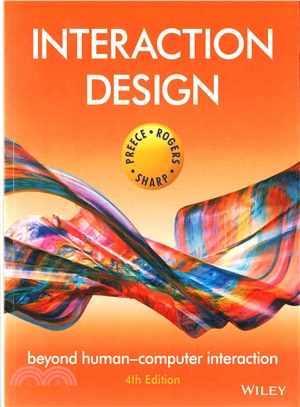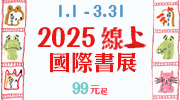Interaction Design ─ Beyond Human-computer Interaction
商品資訊
ISBN13:9781119020752
出版社:John Wiley & Sons Inc
作者:Jenny Preece; Helen Sharp; Yvonne Rogers
出版日:2015/04/27
裝訂/頁數:平裝/584頁
規格:24.1cm*18.4cm*2.5cm (高/寬/厚)
版次:4
商品簡介
A new edition of the #1 text in the Human Computer Interaction field!
Hugely popular with students and professionals alike, Interaction Design is an ideal resource for learning the interdisciplinary skills needed for interaction design, human–computer interaction, information design, web design and ubiquitous computing.
This text offers a cross-disciplinary, practical and process-oriented introduction to the field, showing not just what principles ought to apply to interaction design, but crucially how they can be applied.
id-book.com, the accompanying website, contains extensive additional teaching and learning material including slides for each chapter, comments on chapter activities and a number of in-depth case studies written by researchers and designers.
New To This Edition
The fourth edition of this best-selling textbook has been substantially updated to reflect this dynamic and fast moving field and includes:
Wiley e-text featuring videos and Q&A
A new chapter - Interaction Design in Practice
Coverage of many new and traditional interfaces
25 new talking head videos with HCI experts answering questions like ‘has HCI gone too far?’
A new section on emotional tech and automated emotion
Coverage of AgileUX and the maker movement
New sections on social interaction and social media
作者簡介
Jennifer Preece is Professor and Dean in the College of Information Studies, Maryland's iSchool – at the University of Maryland.
Yvonne Rogers is the Director of the Interaction Center at University College London as well as a Professor of Interaction Design.
Helen Sharp is Professor of Software Engineering and Associate Dean at the Open University.
目次
What’s Inside ix
1 WHAT IS INTERACTION DESIGN? 1
1.1 Introduction 1
1.2 Good and Poor Design 2
1.3 What Is Interaction Design? 8
1.4 The User Experience 12
1.5 The Process of Interaction Design 15
1.6 Interaction Design and the User Experience 19
Interview with Harry Brignull 34
2 UNDERSTANDING AND CONCEPTUALIZING INTERACTION 36
2.1 Introduction 36
2.2 Understanding the Problem Space and Conceptualizing Interaction 37
2.3 Conceptual Models 41
2.4 Interface Metaphors 45
2.5 Interaction Types 47
2.6 Paradigms, Visions, Theories, Models, and Frameworks 54
Interview with Kees Dorst 62
3 COGNITIVE ASPECTS 65
3.1 Introduction 65
3.2 What Is Cognition? 66
3.3 Cognitive Frameworks 85
4 SOCIAL INTERACTION 100
4.1 Introduction 100
4.2 Being Social 101
4.3 Face-to-Face Conversations 102
4.4 Remote Conversations 106
4.5 Telepresence 111
4.6 Co-presence 118
5 EMOTIONAL INTERACTION 131
5.1 Introduction 131
5.2 Emotions and the User Experience 132
5.3 Expressive Interfaces 138
5.4 Annoying Interfaces 140
5.5 Detecting Emotions and Emotional Technology 143
5.6 Persuasive Technologies and Behavioral Change 146
5.7 Anthropomorphism and Zoomorphism 152
6 INTERFACES 158
6.1 Introduction 158
6.2 Interface Types 159
6.3 Natural User Interfaces and Beyond 219
6.4 Which Interface? 221
Interview with Leah Beuchley 224
7 DATA GATHERING 226
7.1 Introduction 226
7.2 Five Key Issues 227
7.3 Data Recording 231
7.4 Interviews 233
7.5 Questionnaires 244
7.6 Observation 252
7.7 Choosing and Combining Techniques 269
8 DATA ANALYSIS, INTERPRETATION, AND PRESENTATION 275
8.1 Introduction 275
8.2 Qualitative and Quantitative 276
8.3 Simple Quantitative Analysis 279
8.4 Simple Qualitative Analysis 291
8.5 Tools to Support Data Analysis 300
8.6 Using Theoretical Frameworks 303
8.7 Presenting the Findings 314
9 THE PROCESS OF INTERACTION DESIGN 319
9.1 Introduction 319
9.2 What Is Involved in Interaction Design? 320
9.3 Some Practical Issues 333
Interview with Ellen Gottesdiener 346
10 ESTABLISHING REQUIREMENTS 350
10.1 Introduction 350
10.2 What, How, and Why? 351
10.3 What Are Requirements? 353
10.4 Data Gathering for Requirements 361
10.5 Data Analysis, Interpretation, and Presentation 368
10.6 Task Description 370
10.7 Task Analysis 380
11 DESIGN, PROTOTYPING, AND CONSTRUCTION 385
11.1 Introduction 385
11.2 Prototyping 386
11.3 Conceptual Design 397
11.4 Concrete Design 406
11.5 Using Scenarios 409
11.6 Generating Prototypes 409
11.7 Construction 420
Interview with the late Gary Marsden 429
12 INTERACTION DESIGN IN PRACTICE 432
12.1 Introduction 432
12.2 AgileUX 433
12.3 Design Patterns 443
12.4 Open Source Resources 447
12.5 Tools for Interaction Design 448
13 INTRODUCING EVALUATION 452
13.1 Introduction 452
13.2 The Why, What, Where, and When of Evaluation 453
13.3 Types of Evaluation 456
13.4 Evaluation Case Studies 462
13.5 What Did We Learn from the Case Studies? 467
13.6 Other Issues to Consider when Doing Evaluation 469
14 EVALUATION STUDIES: FROM CONTROLLED TO NATURAL SETTINGS 474
14.1 Introduction 474
14.2 Usability Testing 474
14.3 Conducting Experiments 484
14.4 Field Studies 488
Interview with danah boyd 498
15 EVALUATION: INSPECTIONS, ANALYTICS, AND MODELS 500
15.1 Introduction 500
15.2 Inspections: Heuristic Evaluation and Walkthroughs 500
15.3 Analytics 514
15.4 Predictive Models 518
References 523
Index 553
主題書展
更多書展今日66折
您曾經瀏覽過的商品
購物須知
外文書商品之書封,為出版社提供之樣本。實際出貨商品,以出版社所提供之現有版本為主。部份書籍,因出版社供應狀況特殊,匯率將依實際狀況做調整。
無庫存之商品,在您完成訂單程序之後,將以空運的方式為你下單調貨。為了縮短等待的時間,建議您將外文書與其他商品分開下單,以獲得最快的取貨速度,平均調貨時間為1~2個月。
為了保護您的權益,「三民網路書店」提供會員七日商品鑑賞期(收到商品為起始日)。
若要辦理退貨,請在商品鑑賞期內寄回,且商品必須是全新狀態與完整包裝(商品、附件、發票、隨貨贈品等)否則恕不接受退貨。
























